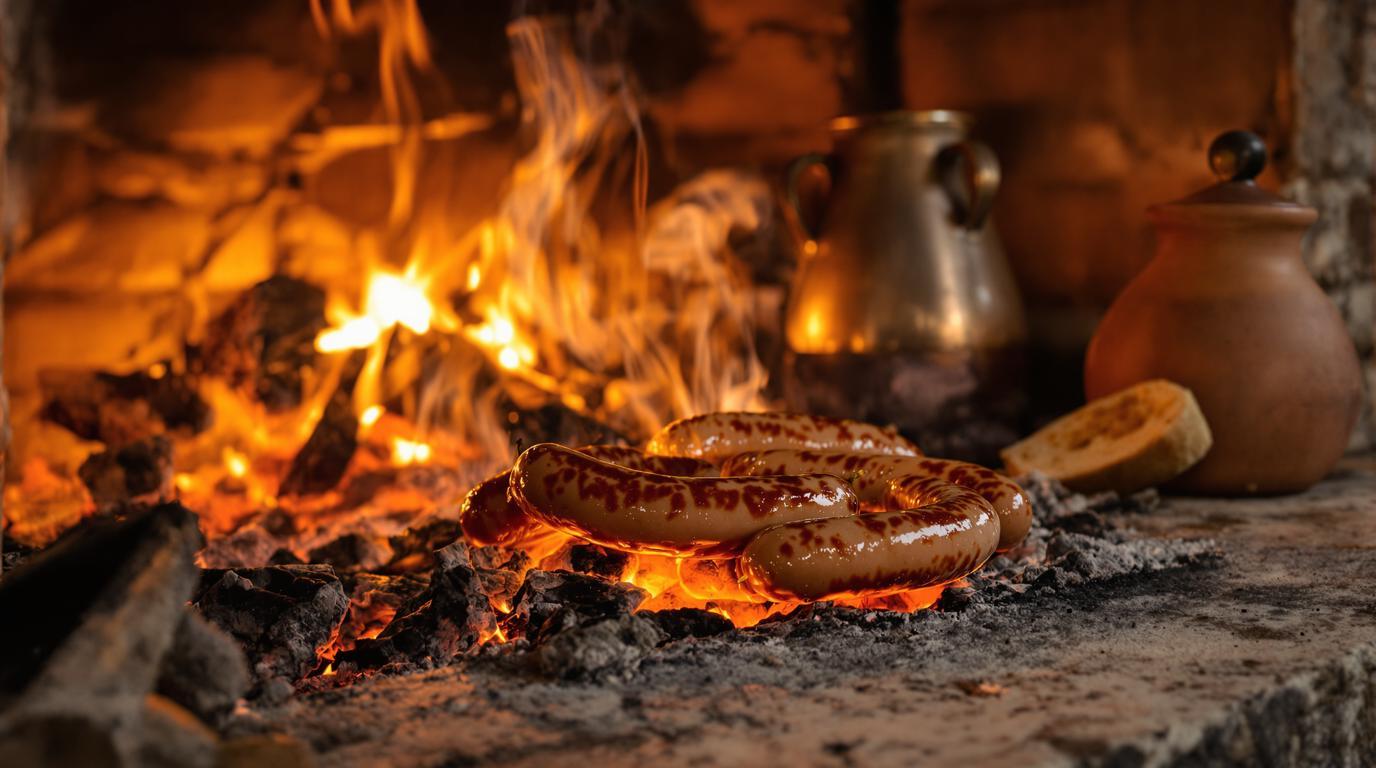Growing up in Provence, I would wake to the intoxicating aroma of wood smoke and pork wafting through morning air. My grandfather, a retired butcher from Toulouse, would already be tending his fire, preparing what would become my culinary foundation—authentic Toulouse sausages. “The fire does half the work,” he’d whisper, adjusting embers with a worn wooden paddle. These sausages weren’t just food; they were a regional celebration, a testament to southwestern France’s mastery of charcuterie and fire. Today, I’m sharing my grandfather’s recipe, perfected over twenty years of professional kitchens, but always returning to those morning fires.
The Legacy of Toulouse Sausage 🇫🇷
Toulouse sausage holds a special place in French culinary heritage—a cornerstone of Gascon cuisine that serves as the heart of cassoulet in winter months, but truly shines when simply grilled over wood fire in summer. Unlike heavily spiced varieties, Toulouse sausage celebrates the pure flavor of quality pork, enhanced only by subtle garlic, white wine, and the unmistakable kiss of nutmeg. This restraint reflects the soul of French cooking: let exceptional ingredients speak for themselves.
While exploring traditional recipes at regional cooking schools, I discovered each family guards their sausage recipe like precious heirlooms. Some add a whisper of black pepper, others might include a touch of cayenne—particularly in Carcassonne. What remains constant is the coarse grind and perfect fat-to-meat ratio that creates that signature juicy interior and crackling exterior.
Essential Ingredients 🧅
For authentic Toulouse sausages (serves 4-6):
- 2 pounds (900g) pork shoulder, coarsely ground
- ½ pound (225g) pork back fat, finely diced
- 3 cloves garlic, minced
- ¼ cup (60ml) dry white wine (preferably from Southwest France)
- 1 teaspoon (2g) freshly grated nutmeg
- 1½ teaspoons (9g) kosher salt
- ½ teaspoon (1g) freshly ground black pepper
- 5-6 feet pork casings, rinsed and soaked
Chef’s Note: The quality of pork makes or breaks this recipe. Seek heritage breeds with proper fat marbling—I’ve used Berkshire pork for years with outstanding results. If you don’t have access to casings, form the mixture into 6-ounce patties and grill like heirloom burgers, though traditional casings create that distinctive snap that’s irreplaceable.
Crafting Authentic Toulouse Sausage 🔪
- Chill all equipment—grinder parts, mixing bowls, and meat—at least 30 minutes before beginning. Cold ingredients prevent fat smearing, essential for proper texture.
- Combine ground pork shoulder, diced back fat, minced garlic, white wine, nutmeg, salt, and pepper in a chilled bowl. Mix gently with your hands just until ingredients are evenly distributed—overmixing creates dense sausage.
- Fry a small test patty to check seasoning, adjusting salt if needed.
- Using a sausage stuffer, fill casings loosely, leaving room for expansion. Twist into 6-inch links, pricking any air pockets with a sterilized needle.
- Rest sausages uncovered in refrigerator 4-12 hours to develop flavor and dry casings slightly.
Wood-Fire Grilling Technique 🔥
The defining character comes from proper wood-fire grilling. I learned this technique watching elderly butchers at southern French markets who treated grilling as meditation rather than cooking.
- Build a hardwood fire using oak, apple, or hickory (olive wood is traditional but difficult to source).
- Allow fire to burn down to glowing embers—roughly 300°F (150°C). Create dual heat zones: hot direct heat and moderate indirect heat.
- Bring sausages to room temperature 30 minutes before grilling.
- Begin cooking over indirect heat for 8-10 minutes, turning frequently.
- Finish over direct heat to crisp casings, about 4-5 minutes, turning constantly to prevent splitting.
- Internal temperature should reach 155°F (68°C).
- Rest sausages 5 minutes before serving, allowing juices to redistribute.
This method is similar to traditional barbecue approaches—patient, indirect cooking that respects the ingredient.
Serving Traditions 🍽️
The most authentic presentation is deceptively simple: Toulouse sausages arranged on a wooden board alongside a crusty country loaf and small pot of whole-grain mustard. In summer, I add a salad of bitter greens dressed with shallot vinaigrette, while winter calls for braised lentils with a splash of wine vinegar.
Wine pairing is essential—a bold Madiran or Cahors from Southwest France stands up beautifully to the rich sausage. Their tannic structure and dark fruit notes create a regional harmony that exemplifies why local foods and wines evolved together.
Whether paired with simple bread or incorporated into more complex dishes like hearty stews, these sausages connect us to centuries of tradition. Every time I grill them, I’m transported back to my grandfather’s garden, learning that patience and respect for ingredients are the true secrets to extraordinary food.
